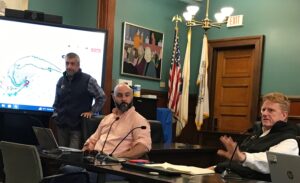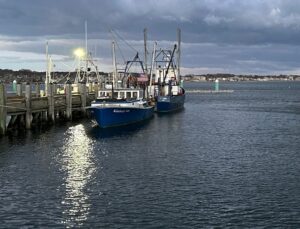PROVINCETOWN — Hydraulic dredging for surf clams has long been a contentious topic in Provincetown — where the town has been active in managing fishing off Herring Cove.

This is the only town in the Commonwealth that has required fishermen who already have state-issued sea clamming permits to file a notice of intent with the town before dredging. That was a practice begun in 2007 and affirmed in court decisions in 2015 and 2017, which found that the conservation commission could require the notices because the state Wetlands Protection Act applied.
Now, a legislative amendment exempts fishermen from that town requirement. As of July 1, surf clammers will no longer be required to file a notice of intent under the Wetlands Protection Act or under any local bylaw as long as they have the necessary permits from the Div. of Marine Fisheries (DMF).
But while members of the Provincetown Conservation Commission are raising questions about habitat protection, fishermen aren’t necessarily celebrating the change either.
That’s because in hopes of protecting eelgrass — a crucial marine habitat — the DMF is proposing an entirely new approach to establishing the boundaries where clam dredging can happen, and so far it looks as if the proposal may be hard on local fishermen.
Representatives from the Cape Cod Commercial Fishermen’s Alliance, a smattering of town officials, and just one surf clam boat owner, Keith Rose, were at town hall for an Oct. 17 forum to hear Jared Silva, DMF’s senior policy analyst, outline the basics of the agency’s proposed management program.
Drawing the Line Differently
Since the mid 1980s, besides continuing longstanding local closures in areas like Provincetown Harbor, the DMF’s statewide regulations have prohibited the dredging of surf clams shoreward of the 20-foot-depth contour line from May 1 to Oct. 31. From Nov. 1 to the end of April, surf clam dredgers can operate in a larger area but are still prohibited from clamming shoreward of the 12-foot contour line.
Fishing vessels have relied on electronic depth sounders to keep them out of restricted areas, but those require constant watching.
The DMF is proposing to use geofencing technology (which uses GPS or similar locator technologies) to establish a virtual boundary that would approximate the 12-foot-depth line. The agency would then equip the surf clam dredge vessels with trackers that would alert boat operators and the state agency when the line marking protected areas is crossed.
Daniel McKiernan, the director of the DMF, who was also there, said that instead of zigzagging to reflect depth variations, the new line would be straighter. Such a system could also be in some ways more flexible than a strict depth measurement. For example, the boundary could be adjusted to go closer in or farther out in order to close areas to protect beds of eelgrass — or to open areas that don’t have any and where clammers have worked historically.
McKiernan said the system will result in better accountability. The trackers will provide an excellent indication as to where the surf clam dredges are operating, he said, and which may require closer monitoring.
The precision could allow for other changes. For one thing, while night dredging is currently prohibited, McKiernan said that with a tracking system that shows in real time where the boats actually are, the agency might “be inclined to let them fish at night” during the winter.
A Fisherman’s Perspective
Keith Rose, who lives in Wellfleet and owns the F/V Kimberly Ann, which is moored in Provincetown, said at the forum that he dredges off Herring Cove because he consistently finds clams there and he believes it is a sustainable practice. The clamming area there, he said, is “a rich place we’ve fished for years, and it always comes back.”

Done right, Rose said, when the dredging is finished, small clams stay in the sand. He added there was no eelgrass where he fishes.
In a phone interview on Tuesday, Rose said the DMF’s proposed contour line would shut him out of the areas he fishes most. Because it’s an approximation of the 12-foot-depth line and “the main clam biomass is inside that line,” he said, “the restrictions would shatter my business.”
Rose’s boat is about 50 feet long, smaller than other commercial surf clam dredges. And that’s one reason he fishes the waters off Herring Cove. “With a smaller boat, that’s the safest place I can fish in the winter,” he said. “It’s a huge area of sand and clams.”
Rose said he needs more time to fully understand the state’s proposal. “This just happened,” he said. “I’ve got to digest it.”
What About Eelgrass?
The agency’s top priority, Silva said, is eelgrass protection. He displayed a map showing a few areas of the Outer Cape where eelgrass is unprotected by current rules. Silva said that in developing its proposed clamming boundary, his agency had used data gathered by the Dept. of Environmental Protection since 1995.
Mark Adams of the conservation commission asked whether the state agency planned to monitor sediment movement caused by surf clam dredges, and McKiernan said the agency had not intended to do that. “Surf clams, for the most part, will be in dynamic sand,” the director said.
According to the National Oceanic and Atmospheric Administration, surf clamming operations first stir up the seafloor with high-pressure jets of water to expose the clams that live in a few inches of sediment. A heavy sled-type dredge then passes through the sand and scoops up the clams.
Melyssa Millett, the town’s environmental planner and conservation agent, and Timothy Famulare, the community development director, were at the forum with a list of concerns that Millett read aloud. Their focus was on Herring Cove, where Millett said the fishable surf clam habitat is less than one square mile.
Citing a draft study by researchers at the Center for Coastal Studies, their statement raised questions about the potential environmental impacts of loss of habitat and organisms that live on the ocean floor and of increased turbidity, which can affect habitat use and fish reproduction.
The Center for Coastal Studies has not yet published its final report, Millett said, but the town will likely hold a forum on it when results are finalized.
Passing Muster
Massachusetts has only a small fleet of commercial surf clamming vessels, according to McKiernan: there are about 36 surf clam dredging operations with permits in the state, and only 10 of those are active.
The small size of the local fishery seems to have encouraged DMF’s goal of moving forward based on vessel owners’ input about areas they currently fish and concerns they have with the proposed management plan. Likewise, the agency says it wants to work with town officials in establishing the new rules.
McKiernan said his agency would be gathering input across the region for the next six months, and that a new statewide management program will not go into effect until it passes muster with the nine-member Marine Fisheries Advisory Commission, the state’s environmental affairs secretary, and the governor’s office.
Editor’s note: An earlier version of this article, published in print on Oct. 24, incorrectly identified Nate Mayo as the conservation commissioner who asked about monitoring sediment movement. It was Mark Adams who asked.



